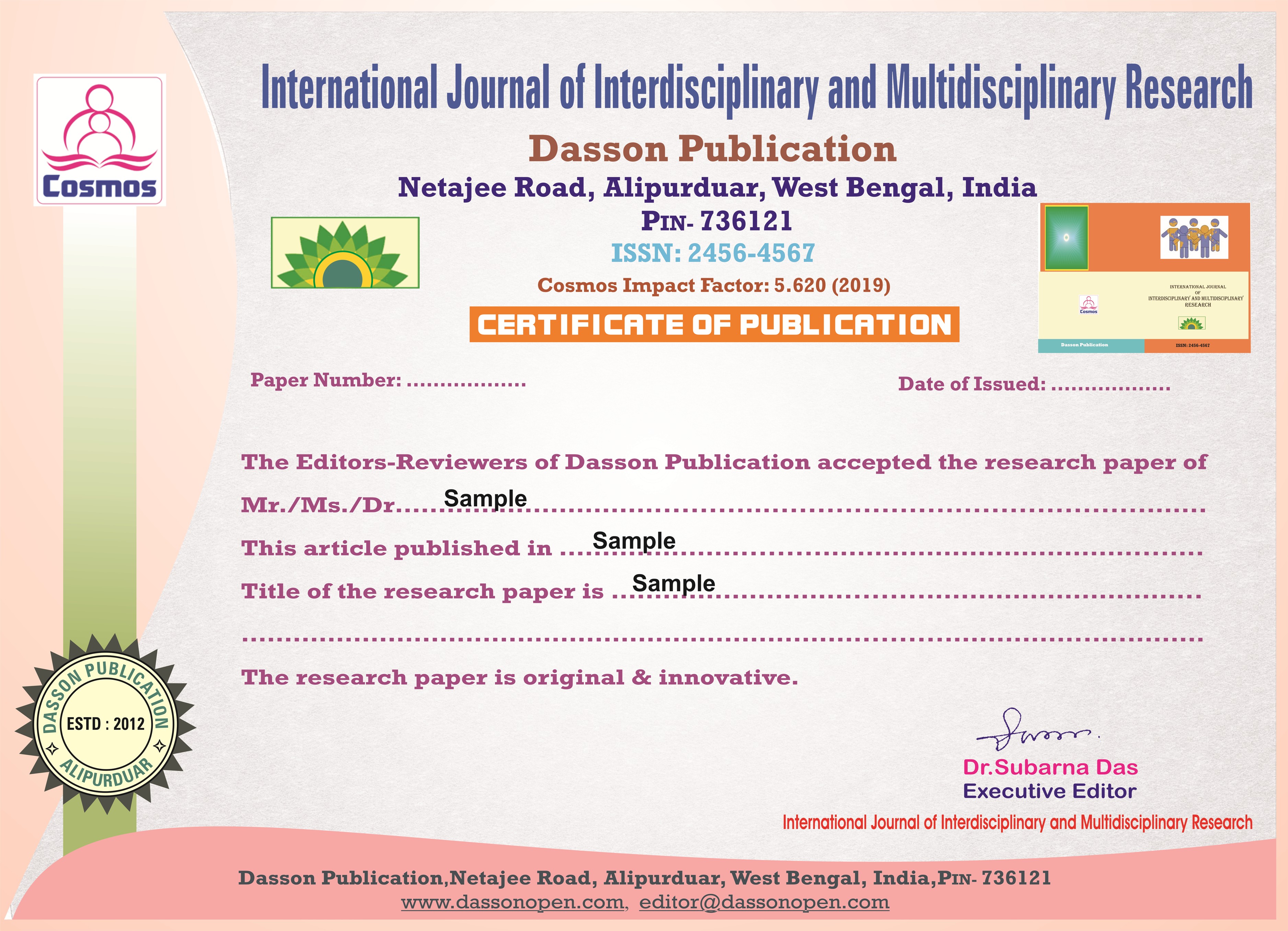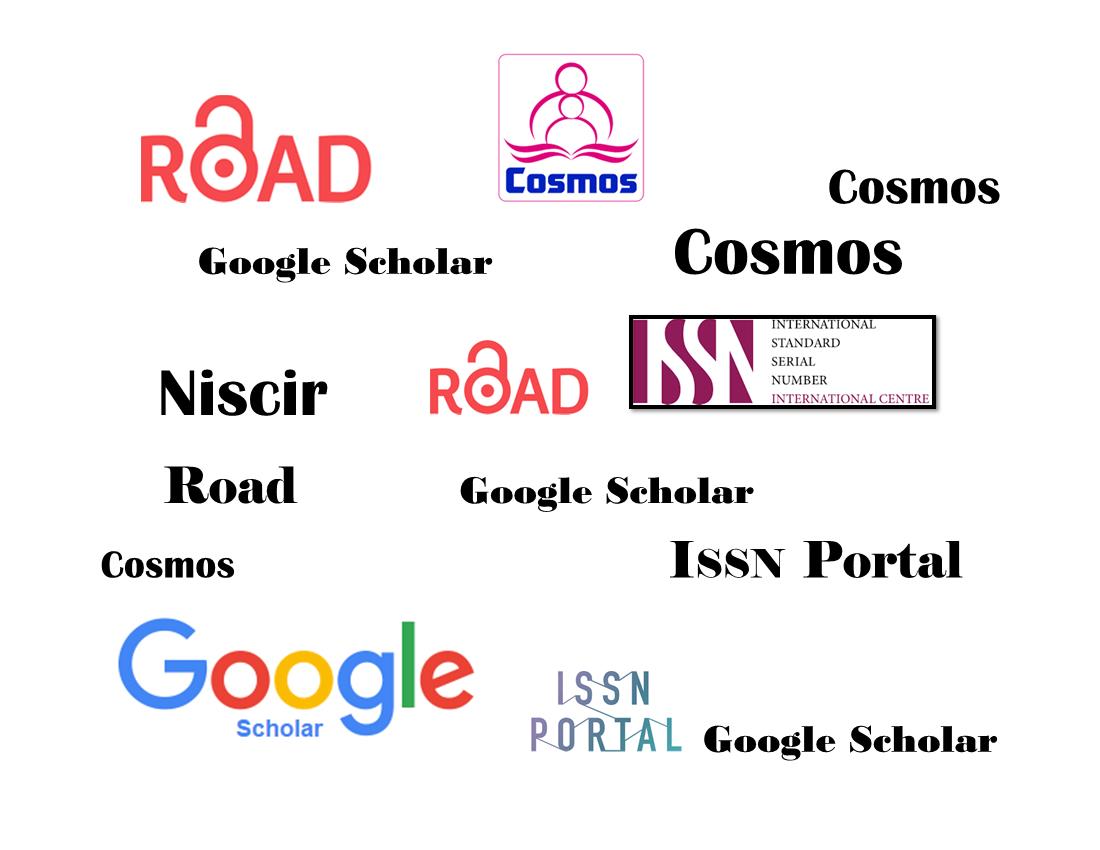Innovations is internationally peer-reviewed journal. Innovations aim to publish original research articles and review articles in diverse fields of Social Sciences and some field of science. This is non-profit, non-stock refereed scientific journal in the world. Innovations is quarterly publication with non-commercial purpose. Innovations Journal has been indexed in the well-known world databases such as 1. Web of Science 2. Road 3. Cosmos 4. Economic Literature (American Economic Association) 5. Scopus 6. Research Papers in Economies (America) 7. Scimago 8. Google Scholar 9. Ugc Care 10. Research Gate 11. Academia Edu 12. French Foundation for Management Education (France) 13. Research Bib 14. National Center for Scientific Research (France). Innovations recognized as a primary instrument for projecting and supporting the goals and objectives, which include scholarly research and the free exchange of ideas. Innovations appreciate systematic reviews, original papers, and peer-reviewed research on all aspects of social science and some field of Science.
Situational Study of Addressing the Water Shortage Problem in Thavinhal Panchayat of Wayanad
Parvathy Ravikumar
The study looks into the water shortage problem faced by the local people of Thavinhal Panchayat at Wayanad district. Wayanad is well known for its large-scale cultivation has scanty rains which contributed to water scarcity. Thavinhal panchayat is a rural local body in Mananthavady Panchayat of Wayanad Zilla Panchayat. The study is a tool to comprehend the water shortage problem and interact with the local residents of Thavinhal Panchayat. Water shortage problem affects the living conditions of the people, as well as it leads to health consequences and accessibility of water for basic needs. The common issues faced by the people are accessibility and quality of water. Therefore, the study is an evaluation from the public about the accessibility and quality of water. This study’s methodology is based on quantitative research. Surveys and questionnaires will be used to gather the data. The study puts on light on the degree of water shortage that residents have attained. The residents acknowledged that during summer season and climate change, their situation worsens. The issue of water shortage problem should be given attention.
Artificial Intelligence in Surgical Decision-Making and Planning : Revolutionizing Innovations, Challenges and Future Directions in Patient Care
1Dr.Ravikiran HR 2Dr.Ashwini NS
Artificial Intelligence (AI) has made significant strides in the healthcare and surgical fields, enhancing diagnostic accuracy, improving surgical outcomes, and personalizing patient care. Technologies such as machine learning (ML), deep learning (DL), and natural language processing (NLP) are transforming medical practices by automating complex tasks, improving clinical decision-making, and facilitating real-time analysis. This review explores the diverse applications of AI in healthcare, from diagnostic imaging and robotic surgery to predictive analytics and patient management. By analyzing findings from 2014 to 2024 studies, we examine the current benefits, challenges, and future prospects of AI in these domains. While AI has demonstrated notable success in various areas, its integration into clinical practice raises concerns related to data privacy, algorithmic bias, and ethical implications. However, the potential for AI to revolutionize healthcare and surgery is immense, and overcoming these challenges will be critical to unlocking its full potential.
"Stepping Toward Healing: Surgical Management of Complex Diabetic Foot Ulcers"
1Dr.Ravikiran HR 2Dr.Ashwini NS
Diabetic foot ulcers (DFUs) are a leading cause of morbidity and disability in patients with diabetes, often leading to infections, amputations, and impaired quality of life. While conservative management strategies such as wound care, offloading, and medical therapies are important, the surgical management of complex DFUs remains a crucial aspect of treatment for many patients. This review article explores the various surgical options available for the management of complex diabetic foot ulcers, their indications, benefits, challenges, and outcomes. Emphasis is placed on surgical techniques aimed at wound debridement, infection control, and reconstruction to prevent amputations and promote optimal healing.
Green Human Resource Management and Sustainable Quality: A Mediating Role of Innovative Technology of SMEs in Ondo State
Igbokwe, P. I.
This study aims to investigate the relationship between Green Human Resource Management (GHRM) and Sustainable Quality (SQ) in Small and Medium Enterprises (SMEs) in Ondo State, Nigeria. The study also examines the mediating role of Innovative Technology (IT) in the relationship between GHRM and SQ. A cross-sectional survey research design was used with a population of 2,363 from SMEDAN 2017. The sample size for this study comprised 341 SMEs located in Ondo State, using a simple random sampling technique. The instrument used was a structured questionnaire, validated with a reliability coefficient of 0.742. Data analysis was conducted using Structural Equation Modeling (SEM – SMART-Pls4) to test the formulated hypotheses. The regression results of the study revealed that the recruitment process explains about 71% of the variance in sustainable quality, while the direct effect of green rewards on sustainable quality was relatively low at 9%. However, training and development showed that the joint effect of GHRM accounts for 40% of the variance in sustainable quality, with all hypotheses being accepted. The study provides practical insights for SMEs in Ondo State, suggesting that they can leverage innovative technology to enhance their sustainable quality.
Agronomic Performance and Multivariate Analysis in Sorghum Genotypes Under Climate-Smart Management Practices in the Central Plateau Zone, Rwanda
Theogene Niyibigira 1,2,*, Wassu Mohammed 3, Tamado Tana 3,4, Tesfaye Lemma Tefera 3, Placide Rukundo5
This study evaluated 36 genotypes for phenology, yield and components, productivity and drought tolerance indices, and responses to conventional and climate-smart practices (tied ridging, mulching, and zai pits). The genotypes showed significant differences under conventional and under combined climate-smart practices. The average grain yield of the genotypes increased by 23.1% under the combined climate-smart management practices. Genotypes Gihove and Nyirakinuma had higher grain yields under both conventional (3664.5 and 3299.0 kg ha-1) and combined climate-smart practices (3953 and 3468.3 kg ha-1). Productivity and tolerance indices showed superior performance for the two genotypes. Correlation analysis showed relative productivity, yield index, and geometric, harmonic, and mean productivity indices as indicators of sorghum genotype yield over combined climate-smart practices. The first and second principal components accounted for 60.83% and 38.57% of the total variability of the genotypes for the 10 productivity indices, respectively. Cluster analysis grouped the 36 genotypes into four clusters, and genotypes Gihove and Nyirakinuma in cluster IV performed well for yield and productivity indices, suggesting that they could be recommended under conventional and climate-smart management practices to achieve high yields with minimal variation after further evaluation. The observed differences indicate the existence of genetic diversity that could be used to develop drought-tolerant and high-yielding varieties in Rwanda.
A Geographical Study of Millets Production in India (Special Reference to Achieving Sustainable Development Goals)
Dr. Anil Kumar Sinha1 & Dr. Rajib Jana2
Millet cultivation plays a crucial role in enhancing food security and promoting sustainable agriculture through its climate-resilient nature and nutrient-rich composition, contributing to both environmental and human well-being. The declaration of 2023 as the ‘International Year of Millets’ by the ‘United Nations’ has sparked renewed global interest in millets. India has played a leading role in promoting millets, highlighting their potential benefits and guiding the world in recognizing their importance. It is also called a ‘Poor Man Food’. India is the largest producer of millet as of 2021, with a total share of 41 %, followed by Niger (~12 %) and China (~ 8 %). The major millets producing states in India are Rajasthan, Karnataka, Maharashtra, Uttar Pradesh, Haryana, Gujarat, Madhya Pradesh, Tamil Nadu, Andhra Pradesh and Uttarakhand. The key objectives of this paper are to analyze the millets production in India with special reference to achieving sustainable development goals. This paper is based on secondary data which is collected from various secondary sources. The main findings is that millets are a highly nutritious, climate-resilient and environmentally sustainable food source that can play a vital role in achieving ‘sustainable development goals’. Millets are found to be very helpful with the reduction of weight, BMI (Body Mass Index) and high blood pressure. Millets are low-cost, highly nutritious food that can help reduce poverty and improve food security, especially in developing countries.
A Survey of Recent Enhancement in Deep Learning for Electronic Health Records (EHR)
Mr. M. Priyadharshan, Mr. Dhanaselvan J U*, Mr. Agash A, Mr. Mohammed Afsal A, Mr. Deepak Raj M.
Nowadays, the usage of the Electronic Health Record (EHR) system in healthcare organizations has increased. The electronic health record consists of a vast amount of sensitive patient information, like clinical notes, laboratory test results, and procedures critical for healthcare and medical research. By the Electronic Health Record, we can perform operations like information extraction, representation learning, outcome prediction, and deidentification. Electronic medical records are more convenient to store and utilize than paper-based records. But in this, ensuring the privacy and security of this data is paramount to maintaining patient trust and complying with the regulatory requirements. In this, we discussed the recent developments in the deep learning techniques to ensure data privacy in the electronic health record and concluded with the challenges of the techniques.
Entrepreneurial Financing and Small Business Enterprise Performance in Enugu State
Okonkwo,Chukwudi Joseph1, Chineze Ifechukwu-Jacobs2, & Chukwujekwu Jeffery Obiezekwem3
This study explores the effect of entrepreneurial financing on the financial performance of small business enterprises (SBEs) in Enugu State, Nigeria. The purpose is to investigate both formal and informal financing sources influence on small business success. A descriptive survey design was used.The sample size was determined based on the Borg & Gall formula, resulting in a total of 270 respondents. A structured questionnaire was developed as the primary data collection instrument, and administered to 270 small businesses cut across the State.Descriptive statistics, such as frequencies, percentages, means, and standard deviations, were utilized to summarize survey responses. The study also used regression analysis for data analysis at 5% level of significance.The findings show that both formal and informal financing have significant positive effects on business performance. The study concludes that policymakers should support both financing avenues and recommends further research on their long-term impact. Entrepreneurs should also be educated on optimizing these financing sources.


